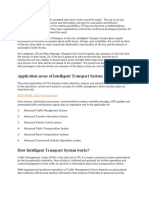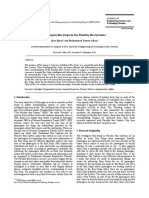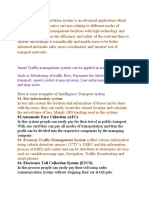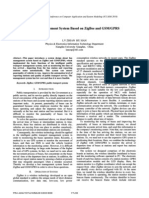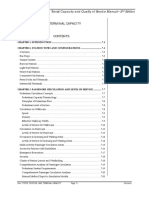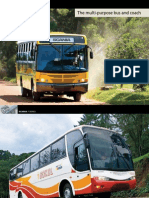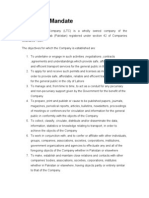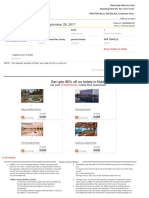GPS-Ticket: Automated Public-Transport Fare Collection System With Cellular Based Remote Transport Scheduling Facility
GPS-Ticket: Automated Public-Transport Fare Collection System With Cellular Based Remote Transport Scheduling Facility
Uploaded by
Abilash VakatiCopyright:
Available Formats
GPS-Ticket: Automated Public-Transport Fare Collection System With Cellular Based Remote Transport Scheduling Facility
GPS-Ticket: Automated Public-Transport Fare Collection System With Cellular Based Remote Transport Scheduling Facility
Uploaded by
Abilash VakatiOriginal Description:
Original Title
Copyright
Available Formats
Share this document
Did you find this document useful?
Is this content inappropriate?
Copyright:
Available Formats
GPS-Ticket: Automated Public-Transport Fare Collection System With Cellular Based Remote Transport Scheduling Facility
GPS-Ticket: Automated Public-Transport Fare Collection System With Cellular Based Remote Transport Scheduling Facility
Uploaded by
Abilash VakatiCopyright:
Available Formats
GPS-Ticket: Automated Public-Transport Fare Collection System with Cellular based Remote Transport Scheduling Facility
Public Transport Problem 1: Fare collection rules of public transport system in India is highly non standard and truly unfair to the traveler and involves huge manual errors. The reason, the fare collection system charges a passenger based on some predefined distance intervals and not on the true distance traveled. For example, in an average city bus a passenger traveling for the first 3 km will be charged say 5 Rs and the next 3 km will add an additional 3 Rs (5+3=8) and so on. The major drawbacks in this are explained here. This is unfair from the passenger point of view because a person who travels just 1 km will be charged the same amount as a person who travels 3 km. A person traveling 4 km will be charged 3 Rs more than a person traveling 3 km. A person traveling 10 km on two transits is charged higher than a person travels the same 10 km on a single transit. The system is highly non standard across the country since each state has its own rules for fixing the travel fare. The fare collection process is still done by manual labors and hence got all kinds of human mistakes.
Public Transport Problem 2: One of the perennial problems faced by the public is to know the current location of the public bus and the exact arrival timing of it at each bus stop. This is faced by people both in rural as well as urban areas which results in unwanted loss of time simply by waiting at the bus stop. It can be questioned whether our transport authority itself has got any knowledge regarding this. So there is no coordination between all of these domains namely, public bus, people and transport authority. Abstract: Our project aim is to design a system that will automate the public transport fare collection process using GPS and contactless smartcard technologies as well as provide a GSM facility to know the present location of the public vehicle and the arrival time at a particular bus stop. The system keeps track of each passenger and charges them accurately based on the total distance traveled by the passenger. Apart from this, the passenger will be able to know the current balance in his smartcard account and can recharge it when needed. Description: The public bus unit has a GPS receiver to find the distance traveled by the passenger during their journey. This unit controls the public bus door gates intelligently using dual Servo Motor, one for entry side and the other for exit side. The passenger entry and exit information is known through this gate control coupled with the smartcard ID. The device communicates with the smartcard using IEEE 802.15.4, a 2.4GHz wireless protocol during the identification and payment process. Each smartcard is equipped with EEPROM permanent memory, a microprocessor and a wireless transceiver. The payment process automatically begins when the smartcard comes near the public bus unit within a range of around 10cm. The public bus unit can also function as a recharge machine for the smartcard. To achieve this smartcard must be inserted into its slot and the user should enter an authentication password and the amount to be recharged using the integrated keypad and the card will get recharged with the amount entered. This is a manual process and should be done by a human operator. A Graphics LCD and a keypad assist this process. The public bus unit also has a GSM modem for cellular connectivity and the user can query it via a simple SMS that has the desired bus stop name coded in it. The bus unit will then send the user an SMS that has the information about the present location of it in terms of the GPS coordinates / location name and the probable arrival time to the bus stop the user mentioned in his SMS. The device could also be used to track the passenger flow in different locations at different times. This data could be used to optimize the public bus number and frequency of visits. The result can be viewed on the user interface display. The device is built around a high performance, low power 32-bit ARM Cortex-M3 microcontroller from NxP Semiconductors. Software Tools Used:
Programming Language: Development Tool:
Embedded C LPCXpresso IDE (Eclipse based)
Embedded Protocols Used: I2C, SPI, UART, NMEA 0183.
Software Libraries Used: Graphics Library NMEA 0183 packet decoder via UART protocol GSM Driver Software via UART protocol IEEE 802.15.4 protocol stack via SPI protocol Cortex-M3 Peripheral Device Driver Library CMSIS from ARM
Project Advantages:
Our system will eliminate the non standard fare collection rules that are prevailing in our country. This will remove the need human labors to collect fare and hence removes the human mistakes associated with this. Integrate Remote location announcement system via SMS will make passenger time very efficient and avoid needless waits and anxiety. The system can also be used by the traffic authorities to control and manage their transportation. The public bus device and smartcard communicates wirelessly making the fare collection process a rapid one in crowded city buses. Secured data transmission based on IEEE 802.15.4 prevents the possibility of fraud that could be possible with other technologies like RFID etc.., More functionality can be integrated such as GPS based location announcement etc.., The device could also be used to track the passenger flow in different locations at different times. This data could be used to optimize the public bus number and frequency of visits.
You might also like
- Smart Card & GPS PDFDocument6 pagesSmart Card & GPS PDFShruti MatthNo ratings yet
- Smart Bus Ticket Using QR Code in Android AppDocument15 pagesSmart Bus Ticket Using QR Code in Android AppNIkhila Reddy100% (1)
- Literature Survey (RFID and Android Based Smart Ticketing and Destination Announcement System)Document3 pagesLiterature Survey (RFID and Android Based Smart Ticketing and Destination Announcement System)ram raneNo ratings yet
- Technical Review On Implementation of GSM Integrated Digital Token Counter SystemDocument4 pagesTechnical Review On Implementation of GSM Integrated Digital Token Counter SystemIOSRjournalNo ratings yet
- Bus Tracking System and Ticket Generation Using QR Technology PDFDocument5 pagesBus Tracking System and Ticket Generation Using QR Technology PDFResearch Journal of Engineering Technology and Medical Sciences (RJETM)No ratings yet
- Automated Ticketing SystemDocument24 pagesAutomated Ticketing SystemUdara SeneviratneNo ratings yet
- Bus Tracking and Ticketing Using USSDDocument7 pagesBus Tracking and Ticketing Using USSDralf casagdaNo ratings yet
- Metrocard For Smart Rider Ticketing System Using Rfid: Intenal GuideDocument11 pagesMetrocard For Smart Rider Ticketing System Using Rfid: Intenal GuidegopiNo ratings yet
- Bus - Report FINALDocument45 pagesBus - Report FINALkshamakbhatNo ratings yet
- Project Report: Smart Passenger Alert SystemDocument8 pagesProject Report: Smart Passenger Alert Systempriyank808No ratings yet
- Batch 1Document30 pagesBatch 1rajeeNo ratings yet
- F6 Hasan - RFID TicketingDocument5 pagesF6 Hasan - RFID TicketingSathyanarayana RaoNo ratings yet
- Submitted To-Submitted byDocument4 pagesSubmitted To-Submitted bydeepkamal_jaiswalNo ratings yet
- Real Time Metroplitan Bus Positionin System Desing Using Gps and GSMDocument4 pagesReal Time Metroplitan Bus Positionin System Desing Using Gps and GSMtjm.stkrNo ratings yet
- Rupee Card Based Bus Ticketing SystemDocument7 pagesRupee Card Based Bus Ticketing SystemAishwaryaNo ratings yet
- Modern Bus Station Using RFDocument65 pagesModern Bus Station Using RFADDU MRUDHULANo ratings yet
- Automatic Bus Recognition Through MobileDocument7 pagesAutomatic Bus Recognition Through MobileseventhsensegroupNo ratings yet
- Low-Cost Bus Tracking System Using Area-Trace AlgorithmDocument8 pagesLow-Cost Bus Tracking System Using Area-Trace AlgorithmInternational Organization of Scientific Research (IOSR)No ratings yet
- Design of Bus Tracking and Fuel Monitoring SystemDocument5 pagesDesign of Bus Tracking and Fuel Monitoring SystemShamran HNo ratings yet
- IEEE Conference Paper Template CompactDocument3 pagesIEEE Conference Paper Template CompactMahesh TamseNo ratings yet
- Rfid Based Metro Train SystemDocument4 pagesRfid Based Metro Train SystemJane VpnNo ratings yet
- Android Smart Ticketing System Using RFIDDocument3 pagesAndroid Smart Ticketing System Using RFIDdropjar100% (1)
- Ijcta,: Abstract: Now A Day at Present We Use Paper Tickets Which Are Printed by A Small Machine With A Key Pad inDocument6 pagesIjcta,: Abstract: Now A Day at Present We Use Paper Tickets Which Are Printed by A Small Machine With A Key Pad insathi karreNo ratings yet
- GPS Vehicle TrackDocument132 pagesGPS Vehicle TrackKarthik DmNo ratings yet
- Advanced Transport Management SystemDocument3 pagesAdvanced Transport Management SystemEditor IJRITCCNo ratings yet
- Automatic Bus Recognition Through Mobile: International Journal of Computer Trends and Technology-volume3Issue3 - 2012Document7 pagesAutomatic Bus Recognition Through Mobile: International Journal of Computer Trends and Technology-volume3Issue3 - 2012surendiran123No ratings yet
- 9.parking Guidance System Utilizing Wireless Sensor Network and Ultrasonic SensorDocument33 pages9.parking Guidance System Utilizing Wireless Sensor Network and Ultrasonic SensorDinesh KumarNo ratings yet
- Monitoring System For Intelligent Transportation System Based in ZigbeeDocument6 pagesMonitoring System For Intelligent Transportation System Based in ZigbeeGabriel DelgadoNo ratings yet
- Challenges in RFID Deployment - A Case Study in Public TransportationDocument9 pagesChallenges in RFID Deployment - A Case Study in Public Transportationsexysaurabh_rdias2146No ratings yet
- Automatic Toll Collection System Using R PDFDocument6 pagesAutomatic Toll Collection System Using R PDFHandy WaveNo ratings yet
- Railway Ticket Booking System Using QR CodeDocument14 pagesRailway Ticket Booking System Using QR CodePrajwal RaoNo ratings yet
- Web Based Bus Tracking SystemDocument4 pagesWeb Based Bus Tracking SystemKrishna EelaNo ratings yet
- Real Time Bus Tracking SystemDocument5 pagesReal Time Bus Tracking Systemharshasai5617No ratings yet
- The Gps Based Cab Monitoring SystemDocument7 pagesThe Gps Based Cab Monitoring SystemyogeshmodiNo ratings yet
- Chapters-Project Report FinalDocument58 pagesChapters-Project Report FinalGarima JainNo ratings yet
- Vehicle Tracking System Using GPS and GSM TechnologyDocument5 pagesVehicle Tracking System Using GPS and GSM TechnologyIJRASETPublicationsNo ratings yet
- Cloud Based Bus Pass System Using Internet of ThingsDocument4 pagesCloud Based Bus Pass System Using Internet of ThingsNadeesha AbeysekaraNo ratings yet
- Smart College Bus Tracking Management System and Its ApplicationDocument6 pagesSmart College Bus Tracking Management System and Its Applicationfna93No ratings yet
- Real Time Vehicle Tracking System Using GSM and GPS Technology-An Anti-Theft Tracking SystemDocument8 pagesReal Time Vehicle Tracking System Using GSM and GPS Technology-An Anti-Theft Tracking Systemعلي عمر محمدNo ratings yet
- Application Areas of Intelligent Transport System: READ MORE: GIS in TransportationDocument2 pagesApplication Areas of Intelligent Transport System: READ MORE: GIS in TransportationIonut CarstovNo ratings yet
- Cloud Based Bus Pass SystemDocument9 pagesCloud Based Bus Pass SystemIT PARTHASARATHI BNo ratings yet
- Ez PassDocument3 pagesEz PassJournal 4 Research100% (1)
- Intelligent Bus Stops in The Flexible Bus Systems: Razi Iqbal and Muhammad Usman GhaniDocument7 pagesIntelligent Bus Stops in The Flexible Bus Systems: Razi Iqbal and Muhammad Usman GhaniRina GasconNo ratings yet
- A Web-Based Traffic Information System Using Wireless Communication TechniquesDocument5 pagesA Web-Based Traffic Information System Using Wireless Communication TechniquesHiron NurulNo ratings yet
- SharanpreetDocument3 pagesSharanpreetporfy2No ratings yet
- Automated Unauthorized Parking DetectorDocument4 pagesAutomated Unauthorized Parking DetectorRaghavendra TalekarNo ratings yet
- Toll Payment Collection Using NFCDocument14 pagesToll Payment Collection Using NFCMuthuCoolNo ratings yet
- Here Is Some Examples of Intelligence Transport SystemDocument2 pagesHere Is Some Examples of Intelligence Transport SystemMehedi Hasan Akash (আকাশ)No ratings yet
- Location Monitoring System Using Raspberry PiDocument4 pagesLocation Monitoring System Using Raspberry PiIJSTENo ratings yet
- Batch13 1stDocument17 pagesBatch13 1st20 Aravinth.N 4005No ratings yet
- Toll Gate2003Document29 pagesToll Gate2003Sana Sarwath100% (1)
- IoT Based Smart Local Transport Tracking SystemDocument4 pagesIoT Based Smart Local Transport Tracking SystemInternational Journal of Innovative Science and Research TechnologyNo ratings yet
- IEEE Paper For Capstone Project PSAPDocument7 pagesIEEE Paper For Capstone Project PSAPSadamate IndrajeetNo ratings yet
- Project ReportDocument18 pagesProject ReportmanisaiyalavarthipatiNo ratings yet
- A Bus Management System Based On ZigBee and GSMGPRSDocument4 pagesA Bus Management System Based On ZigBee and GSMGPRSStephen JoseNo ratings yet
- Design and Implementation of Vehicle Tracking System Using GPSDocument6 pagesDesign and Implementation of Vehicle Tracking System Using GPSiisteNo ratings yet
- Car ParkingDocument14 pagesCar ParkingAnonymous qh5UUGTNo ratings yet
- Gps GSM TrainDocument5 pagesGps GSM TrainrapidtechsNo ratings yet
- Automatic Number Plate Recognition: Fundamentals and ApplicationsFrom EverandAutomatic Number Plate Recognition: Fundamentals and ApplicationsNo ratings yet
- Automatic Number Plate Recognition: Unlocking the Potential of Computer Vision TechnologyFrom EverandAutomatic Number Plate Recognition: Unlocking the Potential of Computer Vision TechnologyNo ratings yet
- Bus Ticket Invoice 1673864116Document2 pagesBus Ticket Invoice 1673864116SP JamkarNo ratings yet
- New BRTS SeminarDocument21 pagesNew BRTS SeminarMohit ZalavadiaNo ratings yet
- Dubai Public Transport Bus Master PlanDocument46 pagesDubai Public Transport Bus Master Planisam mahmoud100% (1)
- Amreli Ahmedabad: Departure ArrivalDocument2 pagesAmreli Ahmedabad: Departure ArrivalSiddharth AhujaNo ratings yet
- Stop, Station, and Terminal Capacity: Transit Capacity and Quality of Service Manual-2 EditionDocument72 pagesStop, Station, and Terminal Capacity: Transit Capacity and Quality of Service Manual-2 EditionkhanNo ratings yet
- Goibibo EticketDocument2 pagesGoibibo EticketChemicalABtechNo ratings yet
- Choose The Best Answer Below!: ExercisesDocument6 pagesChoose The Best Answer Below!: ExercisesTri KusumastutiNo ratings yet
- Developing A Multimodal Transport Hub and Bus Service Improvements For BattaramullaDocument6 pagesDeveloping A Multimodal Transport Hub and Bus Service Improvements For Battaramullasandaru malindaNo ratings yet
- Vocabulary Extension Word List: Unit 3Document1 pageVocabulary Extension Word List: Unit 3NguyenThiPhuongThuyNo ratings yet
- The Multi-Purpose Bus and Coach: Scania F-SeriesDocument12 pagesThe Multi-Purpose Bus and Coach: Scania F-SeriesPhilippine Bus Enthusiasts SocietyNo ratings yet
- An Investigation of Bus Rapid Transit System (BRT) Based On Economic and Air Pollution Analysis (Tehran, Iran)Document11 pagesAn Investigation of Bus Rapid Transit System (BRT) Based On Economic and Air Pollution Analysis (Tehran, Iran)AnggerNo ratings yet
- Set 1Document12 pagesSet 1deviNo ratings yet
- AITP Draft File2104Document9 pagesAITP Draft File2104Aryann GuptaNo ratings yet
- Problems With Metro of QuitoDocument15 pagesProblems With Metro of QuitoSantiago BritoNo ratings yet
- Urban IssuesDocument147 pagesUrban IssuesAvantika100% (1)
- Smart Cities As Business HubsDocument11 pagesSmart Cities As Business HubsSabyasachi Naik (Zico)No ratings yet
- NJ MVC Title 39 TOCDocument63 pagesNJ MVC Title 39 TOCyitz22No ratings yet
- Cognizant Technology Solutions (CTS)Document37 pagesCognizant Technology Solutions (CTS)Charly TonyNo ratings yet
- Online Bus Ticket Reservation System For Abay Bus TransportDocument49 pagesOnline Bus Ticket Reservation System For Abay Bus Transportelsa love78% (9)
- Module-3 Axle Load, ESAL and Damaging Effect of Axle LoadDocument18 pagesModule-3 Axle Load, ESAL and Damaging Effect of Axle LoadHuzaifa ZafarNo ratings yet
- Company MandateDocument6 pagesCompany MandateazlodhiNo ratings yet
- PrizeDocument9 pagesPrizebtfhdc85skNo ratings yet
- Kapnos Receipt 110013Document2 pagesKapnos Receipt 110013Iftime VasileNo ratings yet
- DM 1Document61 pagesDM 1kshashank2468No ratings yet
- Power SystemDocument1 pagePower SystemelectricalconsultantNo ratings yet
- Essay Samples CAEDocument14 pagesEssay Samples CAEDarkLinkNo ratings yet
- Cadd CentreDocument2 pagesCadd CentrePratik ShahNo ratings yet
- GOBUSAND47E3F37E7ADocument2 pagesGOBUSAND47E3F37E7AUntold DarknessNo ratings yet
- IESA VS2013 ARAI Rashmi UrdhwaresheDocument30 pagesIESA VS2013 ARAI Rashmi Urdhwaresherahul srivastavaNo ratings yet
- Bus TicketDocument2 pagesBus TicketNagabhushan BaddiNo ratings yet







































